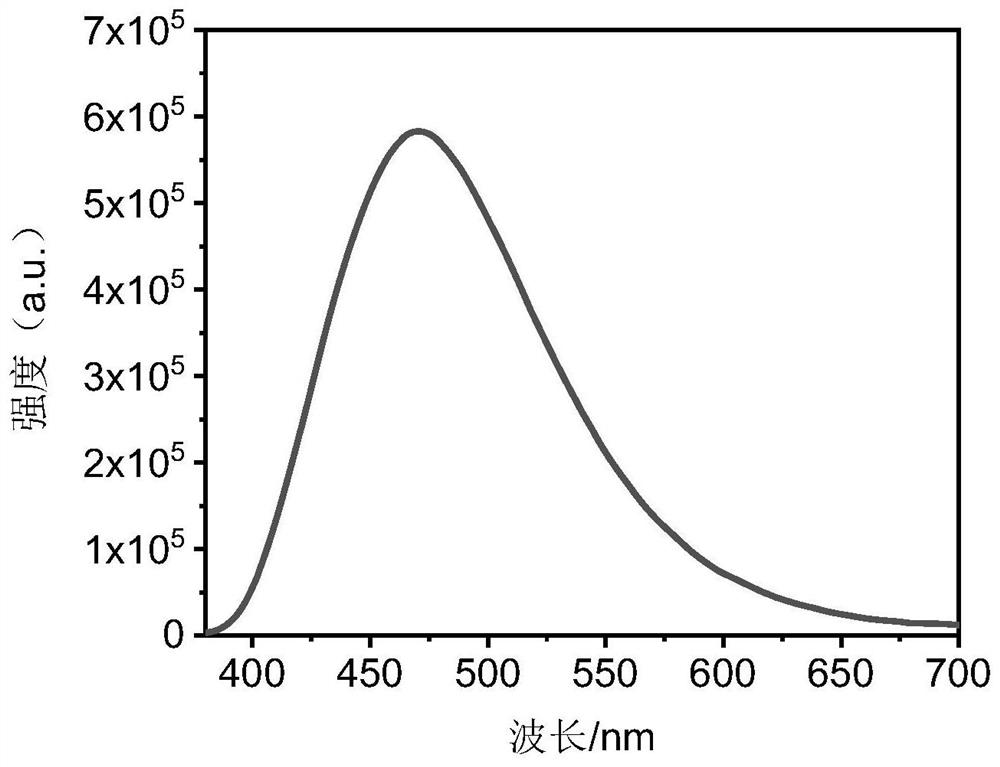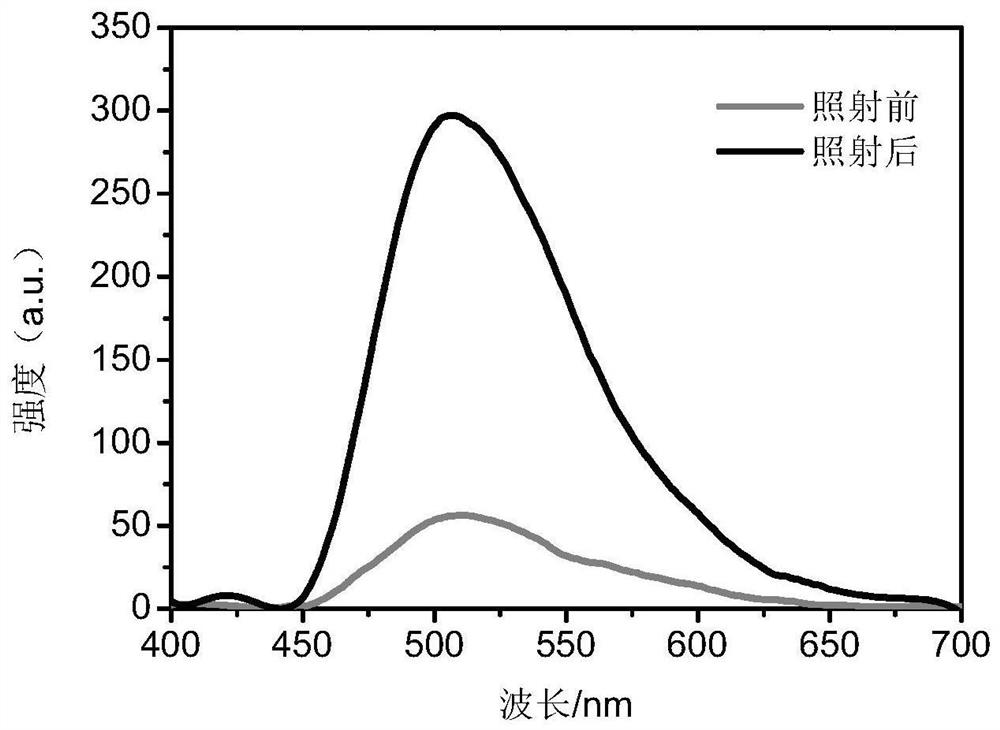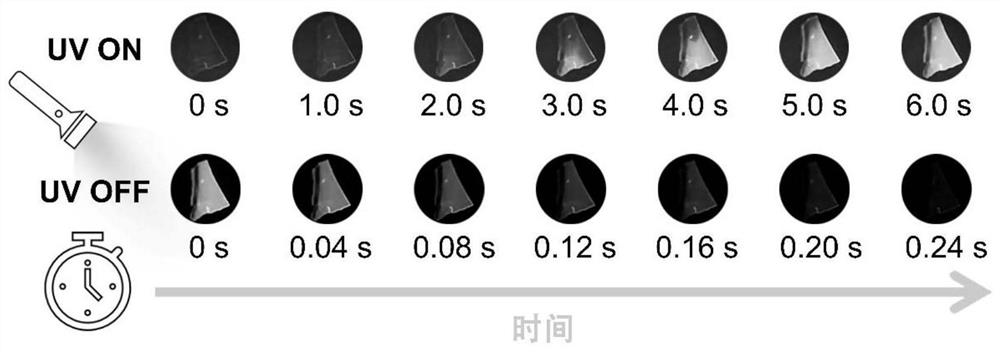Pure organic room-temperature phosphorescent material based on thiochromanone derivative as well as preparation method and application of pure organic room-temperature phosphorescent material
A technology of room temperature phosphorescence and thiochroman, which is applied in the fields of luminescent materials, organic chemistry, chemical instruments and methods, etc. It can solve the problems of lack of types of phosphorescent groups, restrictions on the development and application of pure organic room temperature phosphorescent materials, and low phosphorescence quantum yield. , to achieve high absolute phosphorescence quantum yield, stable luminescent properties, and low price
- Summary
- Abstract
- Description
- Claims
- Application Information
AI Technical Summary
Problems solved by technology
Method used
Image
Examples
Embodiment 1
[0028] The guest material of the pure organic room-temperature phosphorescent material provided in this example is thiochromanone, and the host material is polyvinyl alcohol, both of which are directly purchased from a reagent company. The specific steps for preparing pure organic room temperature phosphorescent materials are:
[0029] Weigh 3 mg of thiochromanone and 1000 mg of polyvinyl alcohol and dissolve them in 5 mL of tetrahydrofuran and 30 mL of deionized water, respectively. After complete dissolution, the tetrahydrofuran solution was slowly added dropwise to the aqueous solution under vigorous stirring. After mixing evenly, the solvent was removed by a rotary evaporator, and a colorless transparent film was obtained after drying in a vacuum oven. The film produces bright cyan phosphorescence when excited by 365nm light. The phosphorescence emission intensity of the material does not increase with the irradiation of ultraviolet light. The maximum emission wavelengt...
Embodiment 2
[0031] The room-temperature phosphorescent material provided in this embodiment is compound 3 (having the structure shown in formula I, wherein R is ) as the guest material, with polymethyl methacrylate as the host material, the specific steps for preparing a pure organic room temperature phosphorescent material are:
[0032] The synthetic method of compound 3 is:
[0033]
[0034] (1) Compound 1 (2.9 g, 10 mmol) was added to a mixture of 2M aqueous sodium hydroxide solution (20 mL) and tetrahydrofuran (40 mL). Reflux for 12 hours. After cooling to room temperature, adjusting the pH value to 6, the aqueous layer was extracted with ethyl acetate. The organic layer was concentrated and purified by column to obtain compound 2 (2.4 g). The H NMR spectrum parameters of compound 2 are as follows: 1 H NMR 400MHz, CDCl 3 δ10.15(s,1H),7.491–7.47(m,1H),7.33–7.31(m,2H),3.18–3.15(m,2H),2.70–2.60(m,2H),2.28(s,3H )1.28(s,6H).
[0035] The C NMR spectrum of compound 2: 13 C NMR 1...
Embodiment 3
[0041] Embodiment 3 provides a light-stimulus-responsive room-temperature phosphorescent material and its application in the field of anti-counterfeiting.
[0042] The room temperature phosphorescent material provided in this embodiment includes compound 7 (with the structure shown in formula I, wherein R is F), and polymethyl methacrylate is used as the main material. The specific steps for preparing the room temperature phosphorescent material are:
[0043] The synthetic method of compound 7:
[0044]
[0045] (1) A mixture of compound 4 (1.0 g, 7.8 mmol), compound 5 (1.2 g, 7.8 mmol), potassium carbonate (3.2 g, 23.4 mmol) and acetonitrile was heated to reflux. After reacting for 12 hours, it was cooled to room temperature, and the insoluble matter was filtered off, and the filtrate was concentrated. The obtained crude product was recrystallized from petroleum ether to obtain compound 6 (1.4 g) as a white solid. The proton nuclear magnetic resonance spectrum parameter...
PUM
| Property | Measurement | Unit |
|---|---|---|
| Luminous life | aaaaa | aaaaa |
Abstract
Description
Claims
Application Information
 Login to View More
Login to View More - R&D
- Intellectual Property
- Life Sciences
- Materials
- Tech Scout
- Unparalleled Data Quality
- Higher Quality Content
- 60% Fewer Hallucinations
Browse by: Latest US Patents, China's latest patents, Technical Efficacy Thesaurus, Application Domain, Technology Topic, Popular Technical Reports.
© 2025 PatSnap. All rights reserved.Legal|Privacy policy|Modern Slavery Act Transparency Statement|Sitemap|About US| Contact US: help@patsnap.com



